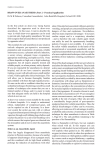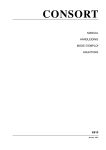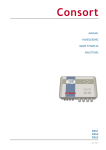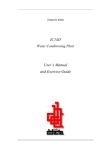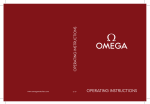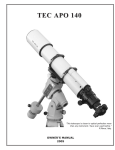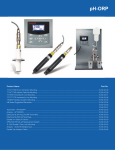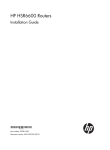Download User Guide - Fondriest Environmental
Transcript
User Guide 9708 Dissolved Oxygen Probes Introduction The Thermo Scientific Orion 9708 dissolved oxygen probe simplifies measurements of dissolved oxygen, particularly Biochemical Oxygen Demand (BOD). The probe allows the dissolved oxygen concentration to be read directly in parts per million on any pH meter, which eliminates the need for a dedicated dissolved oxygen meter. Calibration of the probe is performed in water-saturated air rather than air-saturated water. An zero position on the probe allows the probe to be calibrated without a sodium sulfite solution. An oxygen sensor, thermocompensator, battery operated electronic circuits and operating controls are all included in one probe. The electronic portion of the probe uses extremely low-drain circuits, so the battery life during normal use is minimal. The probe includes a BOD adapter with an overflow funnel and built-in magnetic stirring bar. The 9708 DO probe has a concentration range of 0 to 14 ppm and a temperature range of 0 to 45 ˚C. With one calibration performed per hour, probe measurements are reproducible to ±0.05 ppm or 2% of reading, whichever is greater, if the solution temperature is between 15 ˚C and 35 ˚C and the temperature of the water-saturated air used for calibration is within 10 ˚C of the sample temperature. The probe consumes approximately 0.1 microgram/hour of oxygen. The battery life is one year based on four hours per day operation. 9708 DO Probe User Guide Required Equipment 1. pH meter with a BNC or U.S. standard connection. The 9708 DO probe can be used on any pH meter with a BNC or U.S. standard connection. Thermo Scientific Orion pH meters are recommended, such as the 3-Star pH meter, 4-Star pH/ISE meter, 4-Star pH/DO meter, 4-Star pH/ conductivity meter or 5-Star pH/ISE/DO/conductivity meter. 2. Thermo Scientific Orion 9708 DO Probe. Cat. No. 970899WP has a waterproof BNC connector that is compatible with any pH meter with a BNC connection. Cat. No. 970800 has a U.S. standard connector that is compatible with any pH meter with a U.S. standard connection. 3. Membrane modules, Cat. No. 970801. 4. Batteries, Cat. No. 970803. 5. Magnetic stir plate, required to operate the built-in stir bar on the BOD adapter. Use a stir plate that will maintain a constant stir rate. The speed of many conventional stir plates can be stabilized by placing an aluminum plate on top of the stir plate. 6. BOD bottles. 7. Distilled or deionized water. 9708 DO Probe User Guide DO Probe Preparation Battery Installation 1. Use a small screwdriver or coin to unscrew the cover from the battery compartment of the probe. 2. Remove the batteries from the storage box. Each battery has a flat, positive end and a smaller negative end. 3. Grasp the outside edge of each battery as close as possible to the flat, positive end and avoid touching the negative end with your fingertips. Sweat from the fingers can bridge the insulation between the battery terminals, which causes a significant loss in battery life. 4. Drop the batteries into the battery compartment with the negative ends down. See Figure 1. 5. Replace the battery cover. cover with contact batteries battery component Figure 1 – Battery Installation 9708 DO Probe User Guide Membrane Module Installation The membrane module is pre-filled with a gel electrolyte. 1. Remove the protective shipping cap from the end of the probe. 2. Remove the membrane module from the foil patch. The module is pre-filled with a liquid gel electrolyte. Do not spill or remove the gel electrolyte. Do not touch the anode/ cathode assembly with your fingers. See Figure 2. 3. Unscrew the red plug from the membrane module. 4. Hold the module upright and slowly push the anode/ cathode assembly into it. 5. Slowly screw the module onto the probe until it is finger tight. anode/cathode assembly membrane/ electrolyte module Figure 2 – Membrane Module Installation 9708 DO Probe User Guide Operating Controls The mode switch is used to select the operation mode of the probe. The five positions of the mode switch are OFF, BT CK, ZERO, AIR and H2O. • The OFF position is used when the probe is not in operation. In the OFF position the electronic amplifiers are not operating, but the polarizing voltage is maintained so stable readings will be obtained when the probe is switched to the calibration and operating modes. • The BT CK position is used to check the battery power. Good battery power is indicated by a reading of 13.4 or greater on the pH meter display. • The ZERO position is used to electronically zero the probe. Probe calibration is simplified by electronically simulating the output of the probe in the presence of zero oxygen. • The AIR position is used to calibrate the probe in a water-saturated air solution. • The H20 position is used for sample analysis. The zero calibration control is used to adjust the pH meter reading to zero when the ZERO position is selected on the mode switch. The air calibration control is used to set the barometric pressure on the pH meter display. battery compartment zero calibration control ZERO BT CK AIR H20 air calibration control OFF mode switch Figure 3 – Operating Controls 9708 DO Probe User Guide Overflow Funnel and Stir Bar The BOD adapter includes an overflow funnel and stir bar. The built-in stir bar eliminates the need to retrieve a separate magnetic stir bar from each sample BOD bottle. The funnel provides an overflow reservoir that holds displaced sample solution when the probe is inserted into a BOD bottle. This allows measurements to be made without spilling the sample. After the probe is removed from the bottle, the displaced solution drains back into the bottle. The funnel is designed to act as an probe holder when the probe is inserted into a BOD bottle. electrode sample solution displaced by electrode funnel with built-in stirring bar BOD bottle captive magnetic stirring bar magnetic stirrer Figure 4 - Overflow Funnel and Stir Bar 9708 DO Probe User Guide Measuring Hints • To avoid spilling the sample solution, always remove the probe from the funnel before removing the funnel from the BOD bottle. • Do not touch the anode/cathode assembly with bare fingers when removing the membrane module from the probe. • Slowly insert and remove the probe from the funnel. Rapidly inserting or removing the probe may change the calibration values of the probe. • Thoroughly rinse the probe and funnel separately under running water after exposure to sodium sulfite solutions. • Store the probe in the bottle used for calibration between measurements. • Keep the probe away from any sharp objects that may puncture the membrane. • After installing a new membrane, leave the probe in a BOD bottle with about 50 mL of distilled water for 30 minutes before calibrating. • The probe must be in a BOD bottle and stir rate must be constant for accurate measurements. • Oxygen consumption by the probe can cause a lowered oxygen concentration at the boundary layer between the solution and the probe membrane. For this reason, sample stirring is required. Probe Polarization The probe must be polarized before use. To polarize a new probe insert the batteries into the probe, insert the probe in a BOD bottle with about 50 mL of distilled water and wait 30 minutes. The probe is continuously polarized when the batteries are in the probe, so this process does not need to be repeated unless a new membrane module is installed, the batteries are removed or the battery check gives a low reading. 9708 DO Probe User Guide DO Probe Calibration When a new membrane module is installed, wait 30 minutes before calibrating. 1. Connect the probe to the meter. 2. Prepare a BOD bottle by filling the bottle with about 50 mL of distilled water. 3. Insert the funnel into the BOD bottle and then insert the probe into the funnel. Make sure that the probe is suspended about half an inch above the water and there is no water on the surface of the probe membrane. 4. Turn the mode switch to OFF and set the meter to the pH mode. Calibrate the meter to read 7.00 in the pH mode. For detailed instructions on calibrating the meter, consult your meter user guide. 5. Turn the mode switch to BT CK. The pH meter reading should be 13.40 or greater. 6. Turn the mode switch to ZERO. Use the zero calibration control to set the meter to read 0.00 in the pH mode. 7. Turn the mode switch to AIR. If measurements are being made at sea level, use the AIR calibration control to set the pH meter reading to the barometric pressure divided by 100. If the barometric pressure is unknown, the elevation is above sea level or the sample has a salinity greater than 2 parts per thousand, refer to Appendix I and II to obtain the correct AIR setting. •If the sea level barometric pressure is unknown, multiply 7.60 by the elevation correction factor listed in Appendix I. •If the sea level barometric pressure is known, divide the barometric pressure by 100 and multiply the resulting value by the elevation correction factor listed in Appendix I. •If the sample salinity is greater than 2 ppt, divide the barometric pressure by 100 and multiply the resulting value by both the elevation correction factor listed in Appendix I and the salinity correction factor listed in Appendix II. 8. Turn the mode switch to H20 for sample analysis. 9708 DO Probe User Guide Sample Analysis 1. Insert the funnel into the sample BOD bottle and make sure that the funnel fits tightly with the bottle. Slowly immerse the probe into the funnel. Any sample solution that is displaced by the probe will collect in the funnel. 2. Place the BOD bottle on a magnetic stir plate and gently stir the sample. 3. Turn the mode switch to H20 and set the meter to the pH mode. 4. Wait for a stable dissolved oxygen reading and then record the value. The reading is displayed as parts per million (ppm) of oxygen. 5. Slowly remove the probe from the funnel and then remove the funnel from the bottle. Insert a stopper into the bottle. Rinse the probe and funnel with distilled water. Dry the probe and gently blot the membrane. 6. Place the funnel and probe in a storage bottle. DO Probe Operation Check 1. Calibrate the probe. See the DO Probe Calibration section. 2. Prepare a sodium sulfite solution by dissolving about 15.0 g Na2SO3 in 250 mL distilled water. Transfer the solution to a BOD bottle. 3. Insert the funnel into the BOD bottle and then insert the probe into the funnel. Make sure that the funnel fits tightly with the bottle. Place the bottle on a magnetic stir plate and gently stir the solution. 4. Turn the mode switch to H20. After 2.5 minutes, the reading should be 0.3 ppm or less. 5. Slowly remove the probe from the funnel and then remove the funnel from the bottle. Thoroughly rinse the probe and funnel separately under running water to remove the sulfite. 6. Place the probe in the storage bottle. 9708 DO Probe User Guide DO Probe Storage Store the probe in the BOD bottle used for calibration between measurements and when not in use. Probe Characteristics Probe Response The probe exhibits a time response of 96% of the final reading in less than 30 seconds when going from oxygen-free to airsaturated water. A response time of up to 1.5 minutes may be required if the sample temperature is 5 to 10 ˚C different than the air temperature. Temperature Effects Changes in temperature affect both the permeability of the membrane to oxygen and the solubility of oxygen in water. A dual scheme of thermocompensation is incorporated into the probe and automatically corrects for both of these effects. Reproducibility With one calibration performed per hour, probe measurements are reproducible to ±0.05 ppm or 2% of reading, whichever is greater, if the solution temperature is between 15 ˚C and 35 ˚C and the temperature of the water-saturated air used for calibration is within 10 ˚C of the sample temperature. Stirring Effect The probe uses a membrane with low oxygen permeability, which reduces the consumption of oxygen from the sample and results in minimum errors due to changes in stirring rate. If the magnetic stir plate setting is sufficient for continuous movement of the captive stir bar in the funnel, changing the stirring speed will have negligible (0.05 ppm maximum) effect on the oxygen reading. Module Lifetime In normal laboratory use, the lifetime of the membrane module is approximately three months. 10 9708 DO Probe User Guide Theory Of Operation Sensor The 9708 DO probe is a polarographic sensor. It consists of a pair of polarized silver electrodes and an electrolyte separated from the sample by a gas-permeable membrane. Oxygen diffuses across the membrane and is reduced to hydroxyl ions at the silver cathode according to the reaction: 1. O2 + 2H2O + 4e- ––> 4OHThe electrons necessary for this process are provided by a reaction at the silver anode. Because the electrolyte contains chloride ions, this reaction occurs as: 2. Ag + Cl- ––> AgCl + eAt any given temperature, the current that flows between cathode and anode is directly proportional to the level of oxygen outside of the membrane. Electronics Package Four distinct functions are performed by the circuitry located in the probe’s electronic section. First, the current produced by the reduction of oxygen is converted to a voltage so that the output signal of the probe can be used with a pH meter to provide a direct readout of parts per million (ppm) of oxygen on the pH scale. Second, an offset potential allows the meter reading to be electronically set to 0.00 ppm oxygen when the mode switch is set to ZERO. Third, a temperature compensation circuit corrects for changes in the oxygen permeability of the membrane with temperature. This compensation is applied when the mode switch is set to AIR and H2O. Finally, a second temperature compensation circuit is used when the mode switch is set to H2O to correct for changes in oxygen concentration as a function of temperature. 9708 DO Probe User Guide 11 Theory Of Measurement Partial Pressure To measure the biochemical oxygen demand (BOD) of a water sample, it is necessary to measure the concentration of dissolved oxygen in the sample. However, oxygen probes do not directly measure the oxygen concentration, but rather they measure the partial pressure of oxygen. Fortunately, the conversion of oxygen concentration to partial pressure can be easily done electronically, due to the constant and predictable relationship between oxygen solubility and temperature and total atmospheric pressure. Also, under equilibrium conditions, the partial pressure or activity of oxygen in air-saturated water is equal to that of the oxygen in the humidified air above the water. The partial pressure of any gaseous component in air is the fraction of the total pressure exerted by that component; generally taken to be the total pressure multiplied by the volumetric fraction of that component in air. Air is a mixture of oxygen, nitrogen and other gases. Dry air contains about 20.9% oxygen. The partial pressure of oxygen (pO2) in dry air varies with the barometric pressure, thus: pO2 = barometric pressure x O2 fraction Therefore, as standard pressure the pO2 in air is: pO2 = 760 x 0.209 = 159 mm Hg Water vapor is also a gas. The maximum amount of water vapor in air (expressed as a partial pressure) varies with temperature as shown in Figure 5. As the air temperature increases, the water vapor in water-saturated air (air at 100% relative humidity) reduces the partial pressures of the other gases that make up air. For example, at 20 ˚C and standard pressure, the partial pressure of oxygen in water-saturated air is: pO2 = (760 - 17.5) x 0.209 = 155 mm where 17.5 mm is the water vapor pressure at 20 ˚C. 12 9708 DO Probe User Guide It is important to note that at any given temperature the partial pressure of oxygen in water-saturated air is exactly the same in air-saturated water. This means that a probe that is calibrated in terms of partial pressure in water-saturated air will correctly read the partial pressure of the dissolved oxygen in a water sample. Proper calibration requires taking into account the barometric pressure. Therefore, if the barometric pressure is 740 mm, the pO2 of air-saturated water at 25 ˚C is: pO2 = (740 - 23.8) x 0.209 = 150 mm where 23.8 mm is the water vapor pressure at 25 ˚C. Therefore, it is easy to calibrate the probe in terms of partial pressure since only two factors need to be taken into consideration: barometric pressure and the partial pressure of water as a function of temperature. 760 mm 760 mm 760 mm all other gases 9.2 mm 17.5 mm 31.8 mm water vapor 157 mm oxygen 153 mm 155 mm 10 °C 20 °C 30 °C Figure 5 – Partial Pressure of Oxygen in Air-Saturated Water as a Function of Temperature at Standard Barometric Pressure 9708 DO Probe User Guide 13 Concentration Measurements While the probe is, in fact, measuring the partial pressure of oxygen, it can be calibrated in terms of concentration and can be used to read dissolved oxygen levels directly in parts per million. To do this, several additional factors must be taken into consideration. First, the solubility of oxygen in water varies strongly as a function of temperature, as shown in Table 1. Secondly, the solubility also depends on the salinity of the water as shown in Appendix II. Furthermore, the calibration of the probe in terms of concentration also requires that the barometric pressure be known, as indicated by Figure 6. Even ignoring the influence of barometric pressure and salinity, conventional oxygen probes can be calibrated only when the temperature is known, so that the proper value for oxygen solubility can be obtained from a nomogram or table. The 9708 probe incorporates a special calibration mode (based on the variables in Table 1) and a comparison scheme to eliminate the need to measure temperature and look up calibration values. Table 1 - Partial Pressure of Water and Solubility of Oxygen in Water at 760 mm as a Function of Temperature Temperature (˚C) pH2O (mm Hg) O2 Solubility (ppm) 10 09.2 11.28 15 12.8 10.07 20 17.5 09.08 25 23.8 08.26 30 31.8 07.57 35 42.2 06.98 40 55.3 06.47 820 mm 760 mm 700 mm 8.36 ppm O2 9.08 ppm O2 9.80 ppm O2 Figure 6 – Concentration of Dissolved Oxygen in 20 ˚C AirSaturated Water as a Function of Atmospheric Pressure 14 9708 DO Probe User Guide Simplified Calibration The AIR position on the 9708 probe allows the probe to be calibrated in terms of barometric pressure rather than concentration (which varies as a function of temperature). This is possible because the relationship between oxygen partial pressure and air pressure is completely predictable, since air is known to be 20.9% oxygen: 0.209 (barometric pressure - pH2O) = pO2 The calibration in terms of barometric pressure can be carried out in either air-saturated water or water-saturated air, with water-saturated air being easier. Once the probe has been calibrated in the AIR position, correct concentration values will be obtained in the measurement mode. An electronic circuit and temperature sensor built into the probe take into account the factors shown in Table 1 that relate the partial pressure of oxygen to its concentration. For example, before making a measurement the probe must be calibrated. The barometric pressure is 760 mm Hg and the temperature of the room is 20 ˚C. The probe is placed in a bottle containing a small amount of water, which provides the watersaturated air for calibration. After setting the ZERO adjustment, the probe is set to the AIR position and the AIR calibration control is turned to obtain a reading of 7.60 (barometric pressure divided by 100). Then the probe is set to the H2O position. A reading of 9.08 ppm is obtained, which is the solubility of oxygen in ppm at 20 ˚C. One hour later, the room temperature warms to 25 ˚C. The probe is set to the H2O position, and the probe reading changes to 8.26 ppm, the solubility of oxygen at 25 ˚C. When the probe is set to the AIR position, the reading is 7.60. Then the probe is removed from the bottle. The probe is set to the AIR position, and the reading rises slightly to 7.70 or 7.75. This is because the vapor pressure of water is lower in the room air than in the bottle, depending on the relative humidity of the room air, and the partial pressure of oxygen is slighter higher. When the probe is placed in a water sample with a temperature of 30 ˚C and the probe is set to the H2O position, the value obtained for the oxygen concentration is correct even though calibration was performed at 20 ˚C. Failure to calibrate in air that is saturated with water will give rise to about a 2% error. 9708 DO Probe User Guide 15 Appendix I Correction for Elevation This table is used to determine the correct calibration value as a function of elevation. If the sea level barometric pressure is known, it is multiplied by the factor shown in the second column that corresponds to the elevation. If the sea level barometric pressure is not known, it is assumed to be 760 mm and the setting in the last column should be used. Elevation (feet) Elevation Correction Factor AIR Setting (CF x 7.60) 0 (sea level) 1.000 7.60 500 0.982 7.46 1,000 0.965 7.33 1,500 0.948 7.20 2,000 0.931 7.08 2,500 0.915 6.95 3,000 0.899 6.83 3,500 0.883 6.71 4,000 0.867 6.59 4,500 0.851 6.47 5,000 0.836 6.35 5,500 0.821 6.24 6,000 0.806 6.13 6,500 0.791 6.01 7,000 0.777 5.90 7,500 0.762 5.79 8,000 0.748 5.68 8,500 0.735 5.59 9,000 0.721 5.48 9,500 0.708 5.38 10,000 0.694 5.27 10,500 0.680 5.17 11,000 0.666 5.06 Elevation (meters) Elevation Correction Factor AIR Setting (CF x 7.60) 0 (sea level) 1.000 7.60 250 0.970 7.37 500 0.942 7.16 750 0.914 6.95 1,000 0.887 6.75 1,250 0.861 6.54 1,500 0.835 6.35 1,750 0.809 6.15 2,000 0.784 5.96 2,250 0.760 5.78 2,500 0.737 5.60 3,000 0.692 5.26 3,250 0.670 5.09 3,500 0.649 4.93 16 9708 DO Probe User Guide Appendix II Salinity Correction This table is used to determine the correct calibration value when brines, seawater or brackish samples are being measured. The salinity of the final diluted sample should be used to obtain the correction factor. If samples are measured above sea level, the corrected AIR setting obtained from Appendix I should be multiplied by the salinity factor below. Example: A brackish sample having 6 ppt salinity is to be measured at an elevation of 1000 M and a sea level barometric pressure of 740 mm. What is the correct AIR setting? 1. From Appendix I the conversion factor for 1000 M is 0.887, so the corrected sea level barometric pressure is: Corrected Pressure = 740 x 0.887 = 656 mm 2. The salinity correction factor from the table below is 0.94 for 6 ppt. Therefore: Air Setting = 656 x 0.94 = 617 mm = 6.17 on the pH meter Salinity* (parts per thousand) 0 2 4 6 8 10 12 14 16 18 20 22 24 26 28 30 35 40 45 50 Salinity Correction Factor 1.00 0.98 0.96 0.94 0.92 0.90 0.88 0.86 0.85 0.83 0.81 0.80 0.78 0.76 0.75 0.73 0.70 0.66 0.63 0.60 *Salinity is calculated as ppt chloride 9708 DO Probe User Guide 17 Troubleshooting The most important principle in troubleshooting is to isolate the components of the system and check each in turn. Meter The meter is the easiest component to eliminate as a possible cause of error. Thermo Scientific Orion meters include an instrument checkout procedure in the meter user guide. Consult the manual for complete instructions and verify that the instrument operates as indicated and is stable in all steps. Probe Rinse the probe thoroughly with distilled water. If readings continue to be unstable, replace the membrane module. Sample If the probe works properly in standards but not in the sample, look for possible interferences or substances that could alter probe response or physically damage the probe. Technique Check that the method of analysis is compatible with the sample. Interfering Substances Substances such as ozone, sulfides, sulfur dioxide, nitrous oxide and carbon monoxide may interfere with dissolved oxygen measurements. If the measurements are unstable and other troubleshooting procedures do not correct the problem, there may be interfering substances present in the solution. 18 9708 DO Probe User Guide Troubleshooting Chart Issue Recommended Action Unable to calibrate Check the zero setting and adjusted if needed. Verify that no water is on the membrane. Check the batteries and replace if needed. Replace the membrane module. Drift or slow response Check that the solution is being stirred and the stir rate is sufficient. Check the solution temperature. Measurements may take longer if the solution temperature is unstable. Ensure that the probe is fully polarized. Check the batteries and replace if needed. Unscrew the membrane module and slowly screw the module back onto the probe. Check the sample composition. An interfering substance may be present. Replace the membrane module. Measured value low Salt may be present in the sample. Use Appendix II to calculate the AIR setting. Check that the solution is being stirred and the stir rate is sufficient Assistance After troubleshooting all components of your measurement system, contact Technical Support. Within the United States call 1.800.225.1480 and outside the United States call 978.232.6000 or fax 978.232.6031. In Europe, the Middle East and Africa, contact your local authorized dealer. For the most current contact information, visit www.thermo.com/water. Warranty For the most current warranty information, visit www.thermo.com/water. 9708 DO Probe User Guide 19 Ordering Information Cat. No. Description 970899WP 9708 dissolved oxygen probe with BOD adapter, overflow funnel and stir bar; membrane module; batteries and waterproof BNC connector 970800 9708 dissolved oxygen probe with BOD adapter, overflow funnel and stir bar; membrane module; batteries and U.S. standard connector 970801 Membrane module 970802 BOD adapter, overflow funnel and stir bar 970803 Batteries, pack of 2* * For optimum performance, the 9708 DO probe has been supplied with the Eveready 303 batteries. Duracell 357 batteries may also be used. Do not substitute batteries with other models or by other manufacturers. 20 9708 DO Probe User Guide Thermo Fisher Scientific Environmental Instruments Water Analysis Instruments 166 Cummings Center Beverly, MA 01915 USA Tel: 978-232-6000 Toll Free: 800-225-1480 Dom. Fax: 978-232-6015 Int’l. Fax: 978-232-6031 254780-001 Rev.A 0807 www.thermo.com/water























